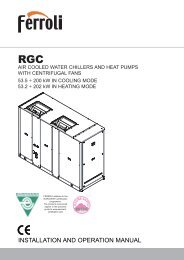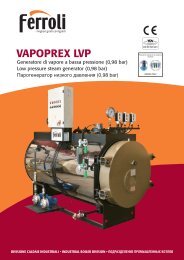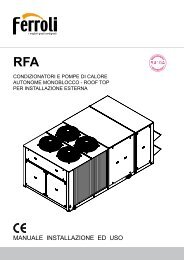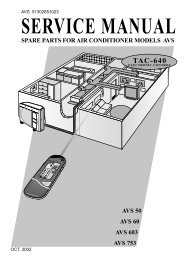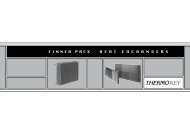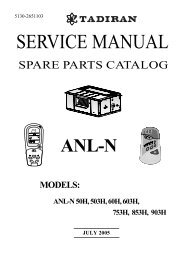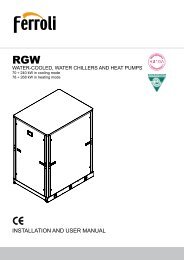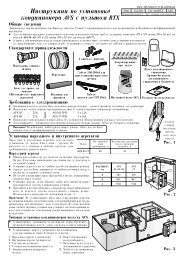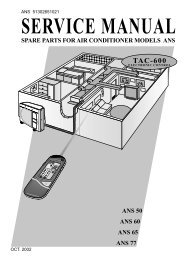BI Comb SGM.GB
BI Comb SGM.GB
BI Comb SGM.GB
You also want an ePaper? Increase the reach of your titles
YUMPU automatically turns print PDFs into web optimized ePapers that Google loves.
Check this through the boiler door, opening it only very slightly,with care. At this point, manually set the screw, primarycombustion air fans and mobile grate in motion. Again adjustthe boiler outlet damper so that the depression in the combustionchamber is 5-6 mm H 2 O. After a certain period of operation,the temperature in the combustion chamber will rise.Slightly increase the opening of the primary combustion airdamper (A1), without however allowing the flame to becometoo violent and the fuel to be projected upwards. Rather, if thebed of fuel tends to rise and the flame is smoky, allow moreair to enter. At this point, open the primary combustion airdampers (A2 and A3), according to the consumption of thematerial deposited on the corresponding grate. If these areempty due to too-rapid combustion of the material being deposited,choke the dampers in question; vice-versa, if the materialtends to accumulate excessively, allow more air in. Whilststressing that this operation must in any case be co-ordinatedby expert personnel, the quantity of air can also be correctedaccording to the % of CO 2 in the flue gas, measured using suitableinstruments. At this point, it may be necessary to adjustthe speed of the mobile grate. This works optimally when it iscovered by material along its entire length. Too slow speedskeep the material heaped at the top, leaving the final gratesempty and thus feeding false air. On the other hand, excessivespeeds spread the material better, yet discharge unburntmaterial into the ash dump. Careful observation in this sense,through the front door, allows the correct speed to be set forthe type of material used. Turn on the secondary combustionair fan, remembering that at this point, the boiler outlet dampermust be re-calibrated so as to reset the depression in combustionchamber. Finally, adjust the secondary combustion airdampers. The quantity of this air also depends on the type offuel, and should be adjusted so as to minimise the amount ofsmoke discharged from the chimney (check against theBacarach number), without excessively reducing the % of CO 2in the flue gas (not below 9%). It must be stressed that thepurpose of the lower and upper above-grate air is to reducethe amount of CO and, given the minimum temperature of500-600°C at which CO begins to oxidise, the above-grate airwill be effective only when the combustion chamber hasexceeded such temperatures. Definitively adjust the boileroutlet damper so as to reset the depression in the combustionchamber. If this oscillates, refer to the average value, withouthowever going below zero, as in this case the boiler will puffsmoke. It should be stressed that this adjustment is extremelyimportant for the efficiency of the boiler. In fact, the only functionof the flue gas exhaust downstream from the boiler is toremove the products of combustion and discharge them intothe atmosphere. If the draught is too strong, that is if thedepression in the combustion chamber is excessive, the gaswill be rapidly discharged from the boiler, and thus not burncompletely and yield of all its heat, with a consequent reductionin thermal efficiency and increase of dust in the chimney.During the initial heating phase, often significant amounts ofcondensation will be formed, deriving from the walls wet by thestill-cool water and the steam released by the refractory material.This is a normal phenomenon, and will not last, for thistype of boiler, more than a few hours or maximum 1.5-2 daysin more severe climates. During the drying phase it is useful, inorder to avoid thermal shock to the refractory material, to proceedwith the boiler at minimum flame, if it features continuousmodulation. Furthermore, stop the combustion process every5-10 minutes for equal intervals, until the temperature abovethe furnace arch, indicated on the electrical panel by the relativeinstrument, gradually reaches and exceeds 500°C. Theheating and drying of the refractory material must be dilutedover a period of at least 12 or more hours. At the end of thedrying phase, fine-adjust the combustion parameters using therelative instruments, and recording the correct adjustment andthe resulting combustion (TEST REPORT). Any variations inhumidity, heat power, density etc. of the fuel during operationwill be further compensated by the action of the oxygen regulatorin the flue gas, if featured in the plant.5.2 BOILER SHUT-DOWN PROCEDURETo avoid shutting down the system with ash melted at somedegree on the surface of the grate, as this can harden andlead to mechanical difficulties during the successive ignition,perform the following procedure before shutting downthe boiler. Place switch in the BOILER SHUT-DOWN position:the MS screw will stop and the boiler will continue tooperate, with the fans and mobile grate in movement, forthe time required to consume most of the fuel on the grate.This time can vary from 0.2 to 1 hour, and is at the discretionof the operator, who can check progress through theaccess door to the combustion chamber. Then proceed toshut-down the boiler, following the indications in point 4.4 ofthe general section of the INSTALLATION BOOKLET.5.3 IGNITIONThis is normally performed using the PILOT BURNER. Thelatter allows the automatic and programmed ignition of theboiler, except in the case of the very first ignition and thefirst ignition for the season or after a certain period of inactivity.The relative switches and combustion chamber temperatureregulation instruments are appropriately set and calibratedby our personnel. The electrical panel is fitted with aFAILED IGNITION safety device, which shuts down the boilerif the flue gas does not reach a set temperature within acertain set time, proof that combustion has not started. Thepilot burner will in this case repeat its cycle. In any case, reignitionshould be handled by the personnel who physicallyfollow the correct effecting of the entire first ignition process,as in the cases mentioned above.19



